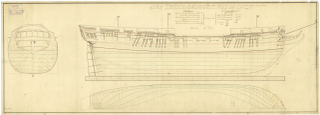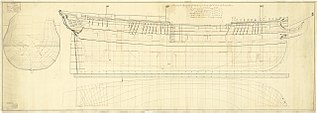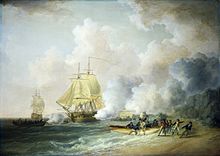
During the 18th and 19th centuries, a sloop-of-war was a warship of the British Royal Navy with a single gun deck that carried up to 18 guns. The rating system of the Royal Navy covered all vessels with 20 or more guns; thus, the term encompassed all unrated warships, including gun-brigs and cutters. In technical terms, even the more specialised bomb vessels and fire ships were classed by the Royal Navy as sloops-of-war, and in practice these were employed in the role of a sloop-of-war when not carrying out their specialised functions.

Steam frigates and the smaller steam corvettes, steam sloops, steam gunboats and steam schooners, were steam-powered warships that were not meant to stand in the line of battle. The first such ships were paddle steamers. Later on the invention of screw propulsion enabled construction of screw-powered versions of the traditional frigates, corvettes, sloops and gunboats.

HMS Speedy was a 14-gun Speedy-class brig of the British Royal Navy. Built during the last years of the American War of Independence, she served with distinction during the French Revolutionary Wars.

HMS Pallas was one of the three 36-gun Venus-class fifth-rate frigates of the Royal Navy. She was launched in 1757 and initially served in Sir Edward Hawke's fleet blockading the coast of France where she fought at the Raid on Cherbourg and in the Battle of Bishops Court. She later served for a number of years in the Mediterranean Sea before moving to serve off the coast of Africa between 1774 and 1776 where she protected the isolated British colonies. In 1778 she joined the Newfoundland Station and participated in the attack on Saint Pierre and Miquelon. Pallas returned to the English Channel after this and assisted in destroying a French invasion force intended for the Channel Islands in 1779 before briefly serving on the Jamaica Station. In 1783 she was beached on São Jorge Island after she was found to be heavily leaking; she was burned there on 24 February.

HMS Active was a 28-gun Coventry-class sixth-rate sailing frigate of the Royal Navy, launched in 1758. She was one of the captors of the Spanish ship Hermione. After Hermione surrendered, her captors found that she carried a large cargo of gold and silver that would lead to the greatest single amount of prize money awarded to the crew of a British warship.

HMS Andromeda was a 32-gun Hermione-class fifth rate frigate of the Royal Navy. She was laid down in 1781 and launched in 1784. She was commissioned for the first time in 1788 when Captain Prince William Henry took command of her and sailed for the West Indies. Prince William Henry paid her off in 1789 and she was not commissioned again until 1790 in response to the Spanish Armament. In 1792 Andromeda joined the Royal Navy's Evolution Squadron in the English Channel before sailing for the Leeward Islands where she stayed until the end of 1793 when Captain Lord Northesk brought her home. She was refitted for much of 1794 before in September joining the Downs Station. Captain William Taylor assumed command in 1795, briefly sailing her to Newfoundland before returning to the North Sea Fleet in 1796. She stayed here for 3 years, seizing the 36-gun Batavian frigate Zefir in the Firth of Forth in March 1798 and participating in the Raid on Dunkirk in July 1800. After another period of service in the Leeward Islands Andromeda returned home at the Peace of Amiens and was laid up at Portsmouth Dockyard where she was broken up in September 1811.

HMS Janus was a 44-gun Roebuck-class fifth rate of the Royal Navy.
HMS Express was the name-ship of a class of two schooner-rigged advice-boats of the Royal Navy. Express was launched in 1800 and served until she was sold in 1813. During her career she served in one action and one campaign that in 1847 qualified her surviving crew members for clasps to the Naval General Service Medal.

HMS Perseverance was a 36-gun Perseverance-class frigate of the British Royal Navy. She served on the North American station until 1787, after which she returned to England, where she was refitted at Portsmouth. In 1789 Perseverance was sent to the East Indies; she returned to Portsmouth in 1793, when she was laid up before finishing her career there as a receiving ship. She was sold and broken up in May 1823.

HMS Roebuck was a fifth-rate ship of the Royal Navy which served in the American and French Revolutionary Wars. Designed in 1769 by Sir Thomas Slade to operate in the shallower waters of North America, she joined Lord Howe's squadron towards the end of 1775 and took part in operations against New York the following year. She engaged the American gun batteries at Red Hook during the Battle of Long Island in August 1776, and forced a passage up the Hudson River in October. On 25 August 1777, Roebuck escorted troopships to Turkey Point, Maryland, where an army was landed for an assault on Philadelphia. She was again called upon to accompany troopships in December 1779, this time for an attack on Charleston. When the ships-of-the-line, which were too large to enter the harbour, were sent back to New York, Admiral Marriot Arbuthnot made Roebuck his flagship. She was, therefore, at the front of the attack, leading the British squadron across the shoal to engage Fort Moultrie and the American ships beyond.

The Thames-class frigate was a 32-gun fifth-rate frigate class of eight ships of the Royal Navy based on the Richmond-class frigate designed by William Bately. The ships were ordered to the older design, which was of a smaller type of ship compared to more modern designs, so that they could be built quickly and cheaply in time to assist in defending against Napoleon's expected invasion of Britain. The class received several design changes to the Richmond class, being built of fir instead of oak, with these changes making the class generally slower and less weatherly than their predecessors, especially when in heavy weather conditions. The first two ships of the class, Pallas and Circe, were ordered on 16 March 1804 with two more ordered on 1 May and the final four on 12 July. The final ship of the class, Medea, was cancelled on 22 October before construction could begin but the other seven ships of the class were commissioned between 1804 and 1806.

HMS Resistance was a 44-gun fifth-rate Roebuck-class ship of the Royal Navy launched in 1782. Based on the design of HMS Roebuck, the class was built for use off the coast of North America during the American Revolutionary War. Commissioned by Captain James King, Resistance served on the West Indies Station for the rest of the war. She captured the 24-gun corvette La Coquette on 2 March 1783 and then went on in the same day to participate in the unsuccessful Battle of Grand Turk alongside Horatio Nelson. Resistance then went for a refit in Jamaica, during which time King fell ill and was replaced by Captain Edward O'Bryen. O'Bryen commanded Resistance until March 1784 when she was paid off. In 1791 she was recommissioned as a troop ship, but was converted back into a warship in 1793 at the start of the French Revolutionary War, under Captain Edward Pakenham.

HMS Jason was a 36-gun fifth-rate Penelope-class frigate, launched in 1800. She served the entirety of her career in the English Channel, mostly in the frigate squadron of Commodore Charles Cunningham. Serving off the coast of France, especially around Le Havre and Cherbourg, she captured several French privateers and recaptured a British merchant ship in a cutting out expedition. Having only been in commission for around fifteen months, Jason was wrecked off the coast of St Malo on 21 July 1801. Her crew were saved and later exchanged, and in August her wreck was burned to prevent the French from rescuing it.

The Perseverance-class frigate was a 36-gun, later 42-gun, 18-pounder fifth-rate frigate class of twelve ships of the Royal Navy, constructed in two batches. Designed by Surveyor of the Navy Sir Edward Hunt the first iteration, consisting of four ships, was constructed as a rival to the similar Flora-class frigate. Strongly built ships, the Perseverance class provided favourable gunnery characteristics and was highly manoeuvrable, but bought these traits with a loss of speed. The name ship of the class, Perseverance, was ordered in 1779 and participated in the American Revolutionary War, but her three sister ships were constructed too late to take part. The class continued in service after the war, but soon became outdated.

HMS Chichester was a two-deck, fifth-rate ship of the Royal Navy. One of the Adventure-class ships designed by Edward Hunt, she was built to carry 44 guns but for her entire career she served as a troopship, never carrying more than 22. In 1803, she was part of the squadron under Samuel Hood that captured the French held islands of St Lucia and Tobago, and the Dutch colonies of Demerara, Essequibo and Berbice.

The Narcissus-class frigate was a 32-gun, 18-pounder fifth-rate frigate class of five ships of the Royal Navy. Designed by Surveyor of the Navy Sir John Henslow, the class was created to make use of shipyards that could not construct larger frigates. They were similar in design to the preceding 32-gun frigate class, the Amphion class, but were slightly shorter. Two ships were initially constructed, with a later batch of three being ordered in response to an Admiralty request for the resumption of production of proven frigate designs. The final two ships of the class were cancelled when the shipyard they were being constructed at went bankrupt. Unlike her sister ships, the name ship of the class Narcissus was armed with experimental short 24 pounders rather than 18 pounders.

HMS Endymion was a 44-gun fifth-rate Roebuck-class ship of the Royal Navy launched in 1779. Based on the design of HMS Roebuck, the class was built for use off the coast of North America during the American Revolutionary War. Commissioned by Captain Philip Carteret, Endymion spent the war serving in the English Channel and West Indies. There, she was damaged in the Great Hurricane of 1780. Sent to England for repairs, Endymion returned to the West Indies in 1782, repeating signals at the Battle of the Saintes. She was present but not engaged at the action of 2 January 1783, before being paid off towards the end of the year.

HMS Experiment was a 44-gun fifth-rate Roebuck-class ship of the Royal Navy launched in 1784. The ship spent her entire career serving as a troop ship, store ship, or lazarette. Initially stationed in the West Indies, Experiment participated in the Battle of Martinique and Invasion of Guadeloupe in 1794. While travelling to Halifax, Nova Scotia, in 1797, the ship captured several high-value Spanish merchant ships, and subsequently returned to Britain. In 1801 she travelled to the Mediterranean Sea where she participated in the Egypt Campaign, with her boats serving as landing craft at the Battle of Abukir.

HMS Actaeon was a 44-gun fifth-rate Roebuck-class ship of the Royal Navy launched in 1778. Commissioned in the same year, the ship served throughout the remainder of the American Revolutionary War. After initially serving in the North Sea and in the defence of the Channel Islands, in 1779 Actaeon joined the Jamaica Station, participating in the capture of Goree on 8 May as she travelled there. She spent time guarding Saint Lucia and Tobago, going to Britain to be repaired before returning to Jamaica in 1781. The ship formed part of a squadron that supported Edward Despard in his capture of the Black River settlement at the Battle of the Black River on 30 August 1782, and then returned to Jamaica to spend the rest of the war patrolling the West Indies.

HMS Regulus was a 44-gun fifth-rate Roebuck-class ship of the Royal Navy launched in 1785. Not commissioned until 1793 for the French Revolutionary Wars, Regulus served predominantly as a troop ship. After initial service in the English Channel she moved to the Jamaica Station where she saw action around Hispaniola and Puerto Rico. Returned to Britain in 1799, the ship served during the Egypt Campaign in 1801 and was present at the Battle of Abukir.

















